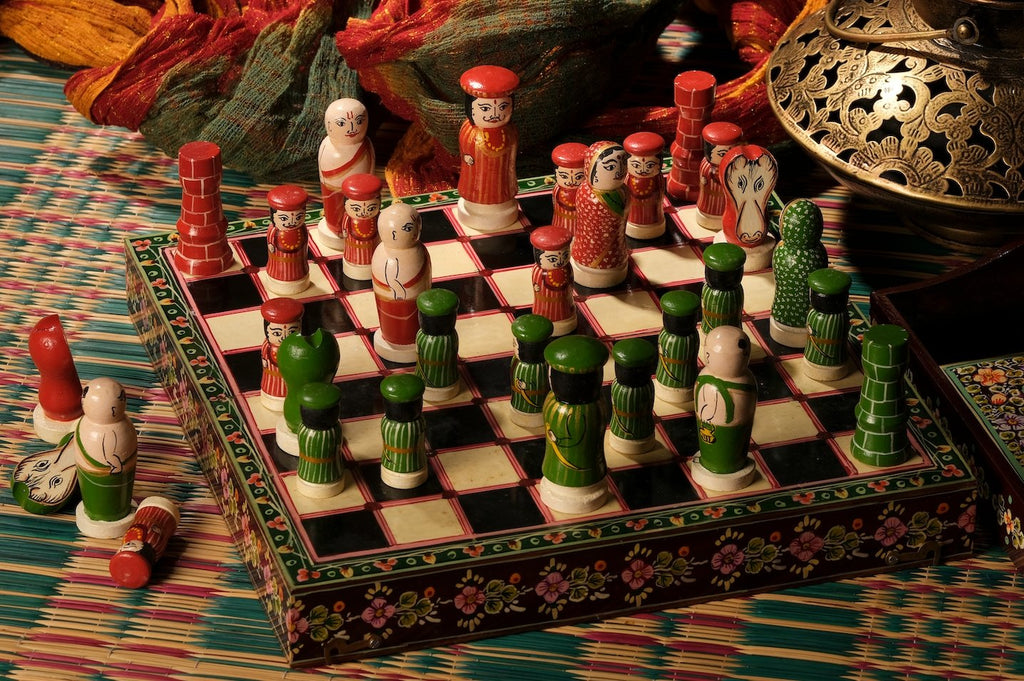Ganjifa is a traditional card game, played among the kings and nobilities, especially during medieval India. The term "Ganjifa" is derived from the Persian word "ganj," meaning "treasure" or "wealth." It is characteristically known for its intricately painted cards and complex gameplay.
History
The origins of Ganjifa are somewhat unclear, but it traces its roots to Persia, gradually reaching India, during Islamic rule. During the Mughal era, Ganjifa became popular among Indian royalty and nobility, particularly in the courts of the Deccan and Rajasthan. A description of the gameplay of this early version of Ganjifa can be found in the Humayun-nama, a 16th-century text by Gulbadan Begum. However, the oldest surviving reference to Ganjifa in India was made in the early fifteenth century by the historian Ibn Taghribirdi, who wrote that a Mamluk sultan gambled with kanjifa (a medieval Arabic name for Ganjifa) as a young man.
The game gained prominence in the 16th century and continued to be played in various regions of India, each adding unique elements and variations to the cards and gameplay. By the 18th and 19th centuries, Ganjifa had become a widely recognized traditional card game in many Indian states, such as Odisha, Rajasthan, Maharashtra, and Karnataka.
Technique and Details
Ganjifa cards are traditionally handcrafted using various materials, including paper, wood, or cloth. The base of the card is made from a variety of materials, but paperboard and wood are among the most common. These materials are cut into circular or rectangular bases, then the intricate designs are hand-painted on them. Natural dyes and squirrel hair brushes are used to paint the imagery on each deck. The artwork draws inspiration from varied sources, including Hindu mythology, with depictions of gods, goddesses, and stories based on the place of origin. The colors are vivid, with red, yellow, green, and blue being prominent. To ensure durability, the cards are often coated with a thin layer of lacquer, which protects the artwork and adds a glossy finish.
Ganjifa decks can vary in size, but the most common configuration is the "Dashavatara" deck, consisting of 120 cards representing the ten avatars of the Hindu god Vishnu. Other decks, such as the "Navagraha," focus on the nine celestial deities in Hindu cosmology. Ganjifa has typically 2-4 players with regional variations about the rules and regulations of the game.
FAQs
How many cards are in a Ganjifa set?
The number of cards in a Ganjifa set can vary. A traditional Dashavatara set usually consists of 120 cards divided into 10 suits, each representing an incarnation of Vishnu. Other sets might have different numbers based on the theme or the specific game.
What are the different styles of Ganjifa?
Ganjifa styles vary by region. Some well-known styles include the Dashavatara Ganjifa from Odisha, Mughal Ganjifa from Rajasthan, and Mysore Ganjifa from Karnataka. Each style features unique artistic elements and themes reflecting the local culture.
What challenges do Ganjifa artisans face today?
Ganjifa artisans face challenges such as declining demand, competition from mass-produced playing cards, and the high cost of handmade production. Efforts to revive Ganjifa include promoting it through cultural tourism, workshops, and online platforms like MeMeraki.
Show Less


















































